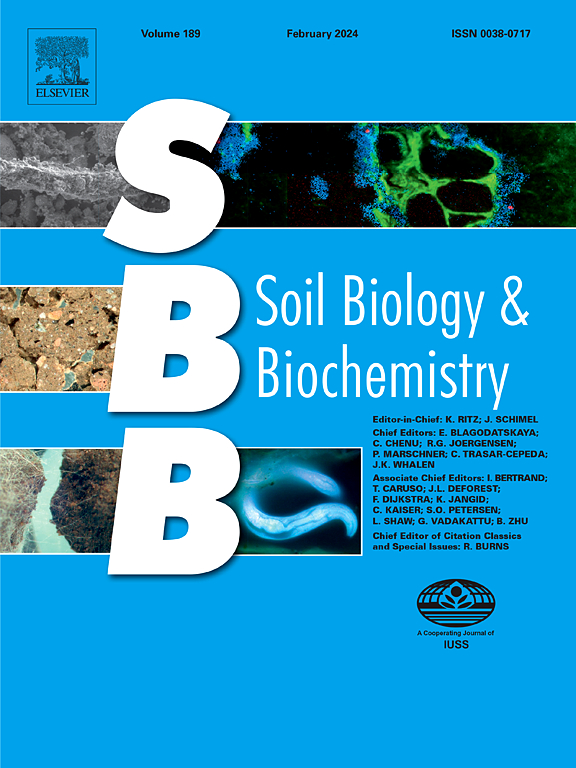Maize roots modulate microbial functional traits in the rhizosphere to mitigate drought stress
IF 9.8
1区 农林科学
Q1 SOIL SCIENCE
引用次数: 0
Abstract
Drought affects soil C sequestration by altering the availability of nutrients to plants and microorganisms. However, the mechanisms of plant-microbe interactions and the potential role of root hairs, which enlarge the root-soil interface, in maintaining rhizosphere processes under drought remain uncertain. We investigated the effect of a 7-day drought on root gene expression in two maize plants, a root hair-deficient mutant and its corresponding wild-type, and its correlation with rhizosphere functions: microbial growth and enzyme kinetics related to organic matter decomposition. Under drought, roots reduced the expression of several chitinase, acid phosphatase and pathogenesis-related genes. In parallel, drought reduced the maximum enzymatic rate of β-glucosidase and acid phosphatase by 3.5- and 1.9-fold, respectively, while the affinity of these enzymes in the rhizosphere increased by 35 and 71 %, respectively, compared to the well-watered treatment. The effect of drought was more pronounced in the rhizosphere of wild-type maize than in that of the mutant. Notably, leucine aminopeptidase and N-acetylglucosaminidase did not respond to drought. Inhibition by high substrate concentrations was observed for β-glucosidase and acid phosphatase only under drought, highlighting the potential use of the substrate inhibition model as a complementary indicator of altered enzyme systems in response to environmental regulators. Finally, drought prolonged the microbial lag phase by up to 24 hours and reduced the microbial specific growth rate by up to 36 % compared to the well-watered treatment. The maximum specific growth rate recovered after rewetting of the soil, demonstrating the sustainability of microbial function after a short-term drought.玉米根系调节根际微生物功能性状以缓解干旱胁迫
干旱通过改变植物和微生物对养分的可利用性来影响土壤碳的固存。然而,植物与微生物相互作用的机制和扩大根-土界面的根毛在干旱条件下维持根际过程中的潜在作用仍然不确定。研究了7 d干旱对两株玉米根毛缺失突变体及其相应野生型根系基因表达的影响,以及其与根际功能的关系:微生物生长和有机质分解相关的酶动力学。干旱条件下,根系降低了几种几丁质酶、酸性磷酸酶和致病相关基因的表达。与此同时,干旱使β-葡萄糖苷酶和酸性磷酸酶的最大酶促率分别降低了3.5倍和1.9倍,而这些酶在根际的亲和力分别比水分丰富的处理提高了35%和71%。干旱对野生型玉米根际的影响比突变体玉米根际明显。值得注意的是,亮氨酸氨基肽酶和n -乙酰氨基葡萄糖酶对干旱没有反应。高浓度底物仅在干旱条件下对β-葡萄糖苷酶和酸性磷酸酶有抑制作用,这突出了底物抑制模型作为酶系统响应环境调节剂变化的补充指标的潜在用途。最后,与水分充足的处理相比,干旱延长了微生物滞后期长达24小时,使微生物特定生长率降低了36%。土壤再湿润后,最大比生长率恢复,表明短期干旱后微生物功能的可持续性。
本文章由计算机程序翻译,如有差异,请以英文原文为准。
求助全文
约1分钟内获得全文
求助全文
来源期刊

Soil Biology & Biochemistry
农林科学-土壤科学
CiteScore
16.90
自引率
9.30%
发文量
312
审稿时长
49 days
期刊介绍:
Soil Biology & Biochemistry publishes original research articles of international significance focusing on biological processes in soil and their applications to soil and environmental quality. Major topics include the ecology and biochemical processes of soil organisms, their effects on the environment, and interactions with plants. The journal also welcomes state-of-the-art reviews and discussions on contemporary research in soil biology and biochemistry.
 求助内容:
求助内容: 应助结果提醒方式:
应助结果提醒方式:


